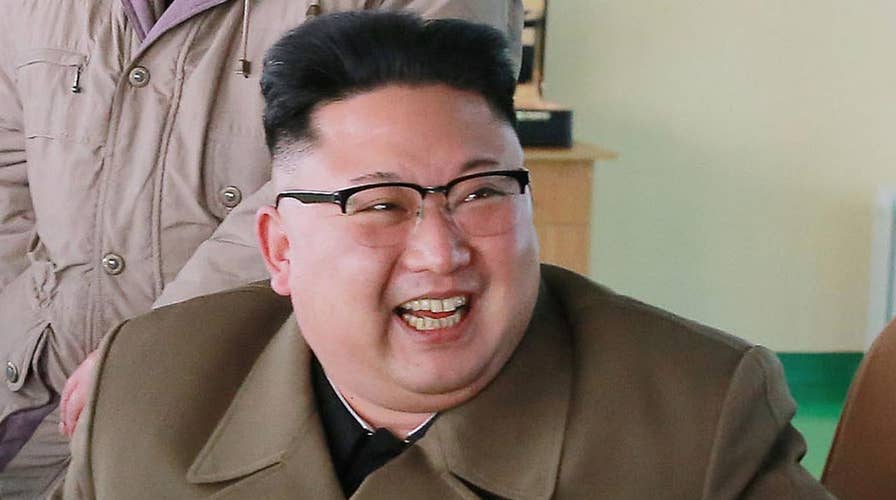What should US do to rein in a defiant North Korea?
Retired U.S. Navy Captain Bob Wells weighs in
The aircraft carrier, USS Carl Vinson, cut through seas off South Korea on Tuesday as Navy F-18 fighter jets took off from the flight deck. This display of US firepower did nothing to calm rising tensions with the Democratic People’s Republic of Korea (DPRK), more commonly known as North Korea.
“While this is a routine deployment for the Carl Vinson strike group, really the centerpiece for us is this exercise we’re doing with the Republic of Korea (ROK) Navy called Foal Eagle,” said Rear Admiral James W. Kilby. The Republic of Korea is typically referred to as South Korea.
NORTH KOREA BURNS AMERICAN AIRCRAFT CARRIER, BOMBER IN PROPAGANDA VIDEO
The ROK and U.S. troops participate in joint drills, billed as defensive in nature, which started March 1. This yearly exercise involves approximately 17,000 American troops and more than 300,000 South Koreans.
Kim Jong Un, North Korea’s leader, warned the United States, South Korea, and Japan of “merciless” attacks if the carrier infringes on its sovereignty or dignity during U.S. and South Korean drills. North Korea said the arrival of the U.S. strike group in the seas off the east of the Korean peninsula was part of a “reckless scheme” to attack it.
SOUTH KOREA PROSECUTORS GRILL PARK OVER CORRUPTION ALLEGATIONS
“If they [meaning the U.S.] infringe on the DPRK’s sovereignty and dignity even a bit, its army will launch merciless ultra-precision strikes from ground, air, sea, and underwater. On March 11 alone, many enemy carrier-based aircraft flew along a course near territorial air and waters of the DPRK to stage drills of dropping bombs and making surprise attacks on the ground targets of its army,” KCNA, the state-run news agency, said.
Last week, North Korea fired four ballistic missiles into the Sea of Japan in response to annual US-South Korea military drills, which the North sees as preparation for war.
In response, the United States began to deploy the Terminal High Altitude Area Defense (THAAD) system a week ago, a day after North Korea launched its latest four missile tests. The United States and South Korea say the anti-missile system is for defense against North Korea.
The United States has also started to deploy “Gray Eagle” attack drones to South Korea, a US military spokesman said on Monday.
Compounding regional tension, China is vehemently opposed to the deployment in South Korea of an advanced U.S. anti-missile system. China fears its powerful radar can probe deep into its territory and compromise its security.
Last week, China called on North Korea to stop its weapons tests and for South Korea and the United States to stop their drills. China says the exercises do nothing to ease tensions in the region. To understand North Korea’s commitment to its nuclear program, one must appreciate that North Korea sees their nuclear weapons as both the source of immense pride and as insurance against foreign forces.
Chinese foreign ministry spokeswoman Hua Chunying, referring to the United States, said, “We hope the relevant side can respect the security concerns of countries in the region, can take a responsible attitude and do more to benefit the easing of tension, rather than irritating each other.”
China has already taken actions in an attempt to halt North Korea from continuing on their path of nuclear weaponization. China has suspended coal imports from North Korea for the rest of the year in response to North Korea testing an intermediate-range missile.
What effect does this action by China have on North Korea and its erratic leader Kim Jong-un? North Korea badly needs to sell coal to earn foreign currency to pay for its imports. Other nations refuse to buy its coal, the sale of which is limited under UN sanctions. This significant move by China unleashed an unusually vitriolic outburst, even by North Korean standards. Kim Jong-un accused China of “dancing to the tune of the US” and “styling itself as a big power.”
North Korea depends heavily on China for supplies of most of its food and energy. China accounts for more than 70 percent of North Korea’s total trade volume. For China to get North Korea to change its ways, it would have to cut off all these and more.
China has good reasons to fear the outcome of such a move that, if undertaken, would very likely lead to the collapse of the North Korean regime.
Jon Harris is an OpsLens contributor and former Army NCO, civilian law enforcement officer, and defense contractor with over 30 years in the law enforcement community. He holds a B.S. in Government and Politics and an M.S. in Criminal Justice.





















